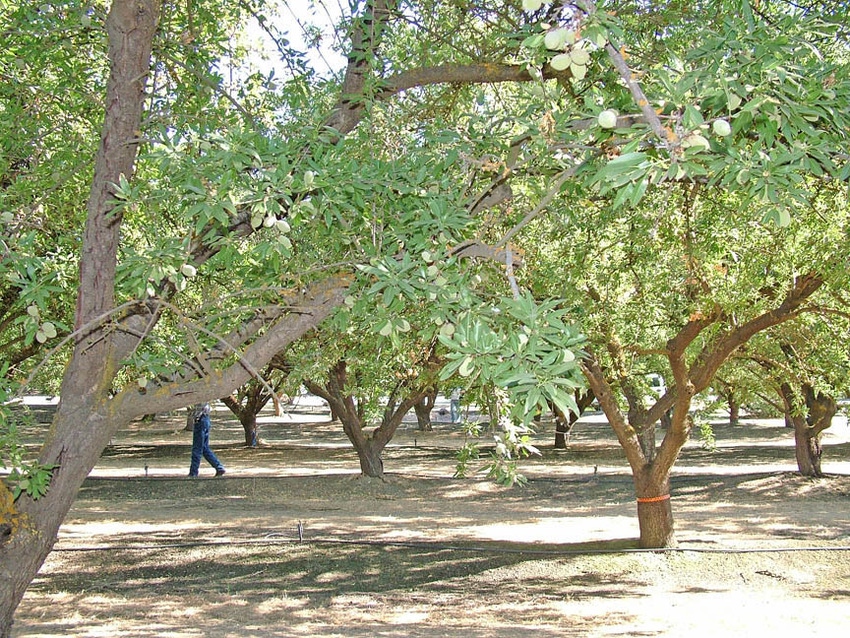
The subjective forecast of a 2-billion-pound California almond crop this year, issued by USDA/NASS, is encouraging news for the state’s growers who have watched the 2012 crop slip recently, says Paul Ewing, sales manager for Hilltop Ranch, Inc., Ballico, Calif.
“That figure is at the low end of the range of industry expectations for the size of this year’s crop,” he says. “It brings some stability to the new crop market which softened slightly prior to the forecast.”
A 2-billion pound crop would be second in size only to the record 2.03 billion pounds production in 2011, and it would be 6 percent larger than last year’s 1.89-billion pound crop that looks like it will come in at 2-billion when all deliveries are logged. The forecast yield of 2,470 pounds per acre this year would be 3 percent higher than last year’s 2,390 pounds per acre yield. Total bearing acreage this year is forecast to be 810,000, the most ever.
“A 2-billion pound crop in 2013 would make for a tight supply in the next marketing year,” Ewing says. “In fact, it’s likely to be the second of a three- to four-season period of relatively tight supply."
This reflects relatively little planting of almond trees from 2008 to 2010 as growers reacted to the low prices being offered for their crops at the time.
Currently, prices being offered for 2013 crop almonds are about 20 cents lower than 2012 crop almonds. However, both are up significantly from year-ago levels, Ewing notes. For example, in limited market activity, kernel prices for 2013 crop almonds are ranging from $2.05 per pound for California varieties and $2.30 per pound for Carmels up to $2.60 per pound for Nonpareils. “Those prices are well above the 10-year historical average of about $1.95 a pound and 15-year historical average of about $1.65 a pound and provide very profitable returns for growers,” he says.
Once recent plantings start coming into full production in 2016, the industry will have an opportunity to expand the market for almonds, Ewing adds. That’s when he expects prices growers receive for their crop to moderate.
Right now, though, this year’s almond crop is developing well, he reports. Wind in mid-April caused some damage to individual almond orchards in both the San Joaquin and Sacramento valleys. However, Ewing doubts it will have a significant impact on the state’s overall almond production this year. “There weresome crop losses,” he says. “But, most of the almonds that blew off the trees would have come down anyway with the normal May or June drop.”
Dry weather concerns
Kernels seem to be sizing well, especially given the potential for a large crop, Ewing reports. He looks for kernel growth to end this May, with hull split occurring about 4 to 5 weeks later.
Growers have experienced few disease threats. Recently, there have been scattered reports of leaffooted plant bug damage.
Although temperatures have been warmer this year than last, heat hasn’t been a concern so far. “Following the very dry winter, there’s some talk that hot weather this summer could be a problem,” he says. “Last year, a combination of high temperatures and little deep soil moisture in June apparently caused some crop losses in terms of fewer and smaller kernels.”
The dry weather since December concerns growers this year and beyond, even in irrigation districts where, historically, they haven’t had to worry about water supplies, Ewing notes. “Growers should have enough water for this year’s almond crop,” he says. “But, some are wondering if they’ll have enough to irrigate their orchards after harvest to prevent stress on the trees and buds and prepare them for the 2014 crop.”
This report is from Tree Nut Farm Press, a twice-monthly electronic newsletter published by Western Farm Press during the growing season. This edition was sponsored by DuPont Crop Protection. If you would like to receive Tree Nut Farm Press go to the Western Farm Press home page and sign up for it and other Farm Press electronic newsletters.
More from Western Farm Press
15 must-ask questions before buying farmland
8 keys to a better wine grape grower contract
Cliff Young — the farmer who outran the field
Almond growers groom $3 billion crop
Sustainability matters to wine consumers
Honey bees: About those neonics
About the Author(s)
You May Also Like




